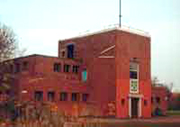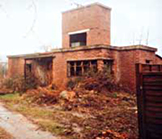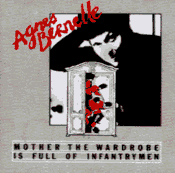|
 |
 |
 |
 |
 |
 |
 |
 |
 |
 |
 |
 |
 |
 |
 |
 |
 |
 |
 |
 |
 |
|
 |
P.W.E. - MILTON BRYAN
|
|
 |
|
|
|
|
|
|
At the end of 1941, Sefton Delmer began recruiting additional staff, in line with the ambition to start a ‘genuine’ German armed forces station. Some time before Christmas, 1942, at Frascatis, his favourite London restaurant, he and those in authority had conceived the idea of the ‘counterfeit' radio stations ‘Soldatensender Calais’ (Soldiers Radio Calais) and Deutscher Kurzwellen-sender Atlantik (German Short-wave Radio Atlantic) and the latter would especially assist an all out offensive against the U-boats, being planned by the Admiralty.
The operation would employ many new weapons and for the purpose of the transmissions Delmer realised that only by live broadcasts, beamed specifically at the U Boats, could a credible psychological effort be obtained. Yet at 'Simpsons', apart from a limited ability, in the case of |
|
|
|
|
|
 |
 |
|
|
|
|
|
|
|
 |
Milton Bryan Propaganda Station, built in 1942 for the Political Warfare Executive to the designs of Edward Halliday.
|
|
|
|
|
|
|
 |
emergencies, live broadcasting was not possible. Soon, however, the required facilities would be introduced, by the building of a modern transmitting station. In 1941, on a visit to Woburn Abbey Eden had asked about the merits of the 7 1/2 KW transmitters then servicing the Wavendon studios and being told that they were hardly of sufficient power, learning that an ultra powerful transmitter lay idle in America, he discussed the matter of purchase with Hugh Dalton, the relevant Minister. Churchill duly received a paper from Dalton who was responsible for all secret broadcast operations and gave his sanction to the idea on 17th. May,1941. Travelling to the U.S., Richard Gambier-Parry then secured the option whilst during the summer months Harold Robin also made the journey, to become familiar with the technicalities of the radio apparatus. |
|
|
|
|
|
|
|
|
|
 |
|
 |
|
|
|
|
 |
|
The Guard House. Armed guards patrolled the site with Alsatian dogs
|
|
|
|
|
 |
At 500KW being too powerful to comply with American law, the equipment had been constructed by R.C.A. for the WJ2 New Jersey commercial station. Unrestricted by the native legal system, however, Robin suggested subsequent modifications that raised the power by 100KW! At Robin's return, plans for purchase and preparation began. An original site for the installation had been chosen in the neighbourhood of Woburn but the prevailing activity, from the local Air Force bases, caused the Air Ministry concerns regarding the height of the aerials which, from the contemporary Gracie Fields song, were indeed the reason for the transmitters nickname of 'Aspidistra', the biggest of it's kind in the world!
In September, 1941, by a decision of the newly created Political Warfare Executive, which replaced the previous propaganda arrangements, the selection of a 70 acre site in Ashdown Forest, near Crowborough, was made for the installation, buried under 30 feet of protective earth and concrete. A decoy installation lay a mile away. Whilst the transmitter itself was located at Crowborough, the studios could be located in the local area. |
|
|
|
|
 |
 |
Agnes Bernelle, a wartime radio announcer at the Milton Bryan studio. As 'Vicki', a 'lanky, spotty - faced, just-out-of-school girl of 15', Agnes became the Germans Vera Lynn and her signature tune, 'A Smooth One', became familiar to thousands of German listeners. Born in Berlin, Agnes escaped to England in 1938 with her playwright and theatre owner father and when her father was asked by the Secret Service if he knew of any girls who could broadcast in German, he suggested Agnes. Ironically, despite her wartime success, when she later applied for a job with the B.B.C. German Service she was told her voice was totally unsuitable for German audiences! Instead she went on to become a leading West End actress. |
|
|
 |
The actual planning of the Aspidistra studio had first been discussed on November 22nd., 1941, with a further meeting, as regards the layout and facilties, on the following day. On December 4th., in further discussions Gambier-Parry then suggested that a new building should be considered and Harold Robin, as the Chief Technical Officer, duly agreed since - in negotiations with the Admiralty - he had been told that Walton Rectory, as a possible location, would have to be kept as overflow accommodation, for the Wrens at Bletchley Park. On December 6th. it was therefore decided to convene a meeting to select a site for the new building and the next day this took place at Woburn Abbey. In attendance were included Harold Robin, Gambier-Parry, Ralph Murray, David Bowes Lyon and Edward Halliday and in conclusion it was agreed that a site in the Park should be chosen, to be selected by Robin and Halliday. On December 8th., after examining the area they found a suitable location near to Paris House; 'Robin and E.H. examined ground in Park near Paris House for suitability for 'A' Studio site. The paddock next to the Bison enclosure is suitable for building (as is the Bison enclosure itself). The aerials to be alongside it with the U.H.F. hut on the higher ground next to Milton Bryant (visual for Dunstable Downs). This would bring the studios in proximity to Paris House, a possible dormitory for 'funnies'. Another possible site is inside the wall near the round reservoir, for both masts and studios with either a landline to the U.H.F. hut near M. Bryant or a tower of wood or steel to hold it at the required height. Robin says either of the above sites would do. The choice will depend on any difficulties that may arise over the "Ducal prejudices".' The findings were presented to David Bowes Lyon and on December 11th. he asked Colonel Gambier-Parry to requisition the site and prepare estimates --- 'Job to go ahead with all speed' and the 'Actual site to be decided by Surveyors'. To eliminate any alternatives, on December 13th. Robin examined another possible site north east of the Abbey, near Eversholt, but thought it unsuitable because it was not as secluded and had no south view. On Christmas Eve, 1941, it was decided to build the new Aspidistra studio of brick --- 'Maycrete though cheap and ready will not make suitable studios' --- and the plans were to be sent to Robin, who would then acquire a tentative price from the builders. Yet before a definite construction began, existing buildings were still being investigated and on January 6th., 1942, Robin visited Potsgrove Rectory, which had certain possibilties, including 'adequate water from a well'. However, there was no light or power. The matter was finally settled on January 8th. by Gambier-Parry who announced that Fighter Command had been allocated the use of the building. Discussions then took place between Gambier-Parry, Robin and the American engineers about the studio set up and control and on January 18th. a meeting of the 'A' Committee was convened at Simpsons, an on site investigation taking place the following day to settle the position. Two estate men, Wilson and Young, then went to the site on February 10th. to dig the trial holes which had to be filled in immediately once the 'men from London' had seen them. A request to the Estate Office was then made that no cattle should use The Gravelpit Field until the holes had been filled in. The surveyors came to inspect the M.B. site on February 17th.
|
|
|
|
 |
|
|
 |
|
|
|
|
|
|
 |
|
|
|
|
|
|
|
|
 |
|
Walton Rectory |
|
|
|
|
|
Potsgrove Rectory |
|
|
|
|
|
|
|
 |
Both of these were considered as a location for the Aspidistra studios, before a decision to construct a purpose built centre was taken.
|
|
|
|
 |
Building commenced on a part of Mr. Lawson's Grange Farm by the Thomas Bates Company of London and Coventry. In the last month of the contract the firm's wages clerk had walked out on his employers and Mr. Lawson's son was able to conveniently fill this temporary position. For reasons of security he was never allowed into the main building. Harold Robin's staff installed all the wiring and equipment and the G.P.O. installed a small switchboard and provided a number of high grade private wires to Potsgrove, Gawcott, Aspidistra, Reuters, the Press Association and the P.O.W. interrogation centres at Latimer and Wilton Park. In due course, completing their work at Milton Bryan, the Thomas Bates Co. then left, to commence a new contract for the aerodrome at Thetford, Norfolk.
Two air raid shelters were situated directly opposite the studio complex and they proved their value late one night in the war, when a lone enemy aircraft, prowling in the skies above Woburn Abbey, lit up the darkness with incendiaries before then returning on it’s track and dropping two high explosive bombs. These narrowly missed two cottages at Battlesden but had they been released a second or so later, then the Milton Bryan station would have definitely been hit.
In the grounds of the Milton Bryan headquarters a multitude of aerials were erected and the wooden poles for these had been especially carted in by a Leighton Buzzard firm. On one occasion great consternation was caused when a fully laden cart overturned!
On Monday 19th. October, 1942, with the police on duty, together with both Colonel Cole, the Home Office Inspector and Commander Willis, the Chief Constable, as Director General of the Political Warfare Executive, Robert Bruce Lockhart officially inspected the Milton Bryan premises. The studios were pronounced very fine with the police quarters described as ‘almost palatial’.
'Delmer’s Circus’, as the 'black' outfit was termed by the white propagandists, acquired an exclusive use of the Milton Bryan studio through the agreement of the Director General and on February 5th, 1943, he and his team took charge of the ultra modern ‘M.B’. The empire enclosed some five acres of grass, tarmac and tarred paths and within this extent stood the main two storey red bricked building, the ‘modernistic’ appearance, designed by Ted Halliday, resembling any of the spate of contemporary new factories. Soundproofing tiles, still to be seen, clad many of the rooms and the walls of an especial inner sanctum had the provision of glass, one inch thick. |
|
|
|
 |
|
|
|
|
|
|
|
|
|
|
|
|
|
 |
|
|
|
|
|
 |
|
|
|
|
|
|
|
Back to top |
|
|
|
|
|
|
|
|
|
|



